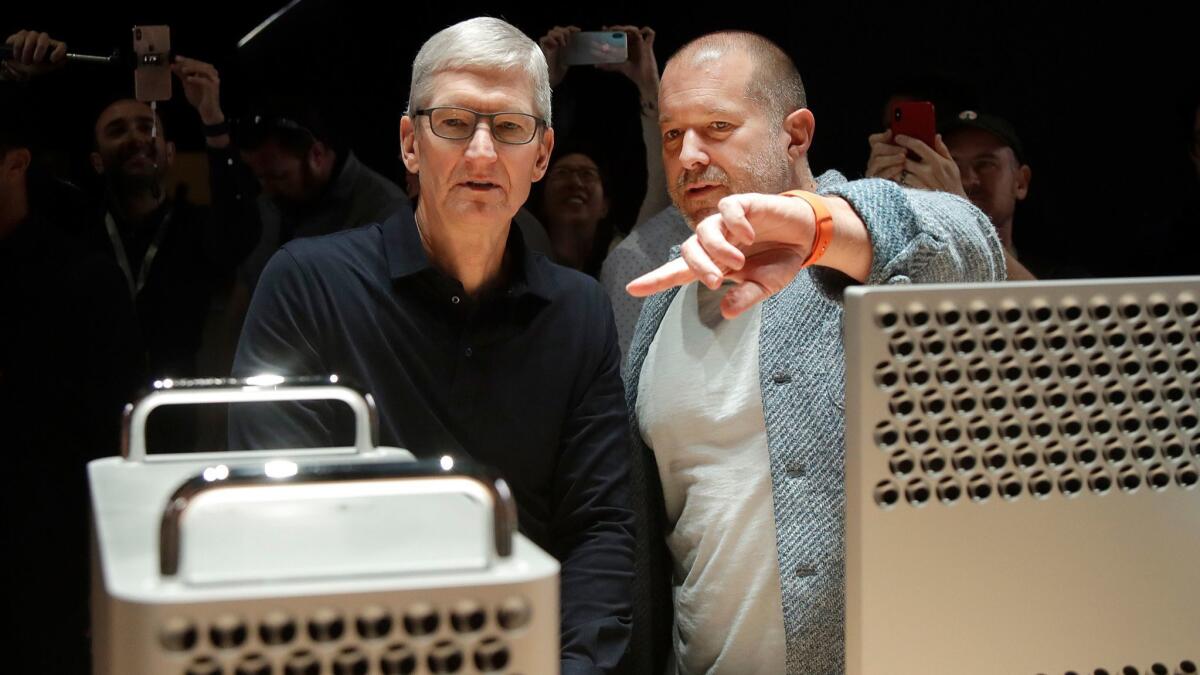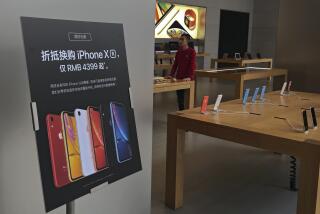Jony Ive’s exit from Apple raises questions about its future

When Jony Ive became leader of Apple Inc.’s design studio in 1996, the company was in a precarious state. It was slashing thousands of jobs to cut costs, and many on Wall Street thought the “insanely great” company had simply gone insane — and might soon go out of business.
Within two years, the turnaround had begun. With co-founder Steve Jobs back in charge, 1998’s release of the candy-colored iMac, designed by Ive, kick-started a prolific and profitable two decades unlike any other in Silicon Valley history.
From the revolutionary iPod and iPhone, through the death of Jobs and onward to its new frontier in wearable devices such as the Apple Watch and AirPods, the British designer has sat serenely at the center.
That era is now drawing to a close as Ive prepares to move on from Apple to launch his own new venture, LoveFrom, after nearly three decades at the Silicon Valley giant.
“Jony is one of a kind,” Tim Cook, Apple’s chief executive, said in an interview this week. “The work on the original iMac was sort of the point at which people began to pay attention to Apple again on something other than how badly economically the company was doing.”
Apple today is financially secure. But Ive’s looming departure will once again raise questions about its future.
This is not the first time Ive’s role has evolved. In recent years, his design expertise has extended beyond crafting Apple’s devices. He helped retail chief Angela Ahrendts overhaul the company’s stores and product packaging.
More significantly, he oversaw the company’s long-planned move to its new headquarters, Apple Park in Cupertino, Calif., which was first conceived with Jobs back in 2004 and designed in partnership with British architects Foster + Partners.
In 2015, Ive handed off managerial responsibilities for the design team to focus on Apple Park. The move prompted some speculation that he was preparing for his exit, but in 2017 he took back those duties. Speaking at a Wired magazine event last year, he appeared to suggest he was back for the long haul, saying: “There’s an awful lot to do and an awful lot of opportunity.”
The completion of the new spaceship-like headquarters would prove to be a watershed moment for Apple’s design team. It brought the entire team together for the first time into one purpose-built studio, with industrial designers sitting side by side with font and interface designers.
“With the completion of Apple Park, that also meant in a way that the vision for this quite extraordinary team was finally enabled,” he said. “Part of the timing for LoveFrom is in some ways connected to having that very clear sense about the health and vitality of the design team.”
Cook agreed: “Perhaps the most important legacy that he leaves ... is the team.”
The power of the design lab
By Apple’s outsized standards, the tightknit group of people who work on product design is small. It runs to just a few dozen people out of an organization that employs some 132,000.
Yet the team wields a disproportionate influence inside the company. With an extensive array of tooling and fabrication equipment rarely found outside a manufacturing plant, the studio explores new product categories and the materials that might be used to build them.
They define not only a product’s appearance but also how its software looks and feels, how it responds to gestures, how an iPhone or Watch gently vibrates to give a user feedback.
“No group within Apple has more power than the industrial designers,” Neil Cybart, an independent Apple analyst with Above Avalon, said in a research report in November. “Jony’s contributions are found in literally every product Apple has shipped during the past 20 years. He oversees the vision guiding the largest design company in history.”
Ive has thousands of patents to his name, encompassing the original iPod and iPhone as well as more obscure innovations, including the iPad’s magnetic cover, the Apple Store’s wooden tables and a lanyard used to attach an iPod to a wrist.
The names that sit alongside Ive’s on those design patents have become familiar to close Apple watchers. For decades after it was created in the late 1980s, Apple’s core industrial design team saw hardly any departures. But recently there has been a noticeable uptick in turnover.
Ive’s departure is likely to reopen a debate that has been simmering for several years: How will Apple come up with a new hit product that can match the unprecedented success of the iPhone, whose record-breaking profits propelled Apple to become the first trillion-dollar company?
Ive dismissed such concerns. “Numbers have never been the measure that I turn to, to affirm or describe the success of a product,” he said. “I’m interested in trying to make things better ... in trying to develop and craft products and experiences that are characterized by their care.”
The shift to services
Despite a slow start for the Watch in 2015, Apple has begun to find success with its accessories, including its wireless AirPods earphones. It also is putting greater attention on an expanding portfolio of online services such as games, news and video. “We are operating at a breadth and depth level that we’ve never operated at before,” Cook said.
Cook and Ive have both pointed to healthcare as a potential new market for Apple, building on the Watch’s new capabilities for detecting heart irregularities. Cook told CNBC this year that health could become Apple’s “greatest contribution to mankind.”
Healthcare is just one example of how the battleground has changed for Apple in recent years. Despite pioneering virtual assistants with Siri, Apple found itself outflanked by Amazon’s Alexa and Google Assistant in sales of smart speakers and in artificial intelligence capabilities. Just this week, Apple acquired Drive.ai, a self-driving car start-up. As Silicon Valley looks to smart glasses and autonomous cars as new frontiers, it is unclear whether its continued reliance on the iPhone for two-thirds of its revenue will prove an asset or a distracting liability.
Some analysts believe new blood could invigorate Apple. Alongside the high-profile departures of Ahrendts and Ive, Apple poached John Giannandrea from Google to become its head of machine learning and AI strategy, as well as Hollywood veterans Jamie Erlicht and Zack Van Amburg from Sony Pictures Television to run its push into original video.
“The apparent acceleration in the pace of change within Apple at the executive level reflects the paradigm shift the company is undergoing from a hardware-driven story to ‘Apple as a service,’ ” Gene Munster, a tech investor with Loup Ventures, said in a note this year. “To successfully capitalize on new opportunities, Apple needs a very different set of skills.”
Perhaps the most significant concern for investors will be that Ive’s move will take away another arbiter of focus and product direction that Apple had already lost with the death of Jobs.
In separate interviews this week, Cook and Ive insisted that no single person at Apple decides which innovations graduate from its R&D labs and which are sent back to the drawing board. “The company runs very much horizontally,” Cook said. “The reason it’s probably not so clear about who [sets product strategy] is that the most important decisions, there are several people involved in it, by the nature of how we operate.”
Meanwhile, Ive’s focus is already starting to look beyond the steel-and-glass borders of Apple Park — he wants to “solve some complicated problems.” He also hinted at an impatience to broaden his horizons.
LoveFrom defies traditional categorization. “I have no interest in creating yet another design agency,” Ive said. “What’s important is the values and what motivates that collection of people.… Small groups of people, I think as Apple has demonstrated over the years, can do some extraordinary things.”
© The Financial Times Limited 2019. All Rights Reserved. FT and Financial Times are trademarks of the Financial Times Ltd. Not to be redistributed, copied or modified in any way.






